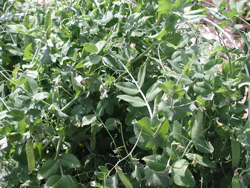Resource Library
Plant of the Week: Snow Pea
The University of Arkansas System Division of Agriculture does not promote, support or recommend plants featured in "Plant of the Week." Please consult your local Extension office for plants suitable for your region.
Plant of the Week
Snow Pea
Latin: Pisum sativum

In these unsettled times, vegetable gardens are back in fashion. In 2007, the vegetable transplant category moved from fourth place in annual sales to second place, behind only lawns. This all happened in the spring of 2007, before the economic meltdown of the fall, so no doubt even more people will be growing a vegetable garden this summer. Though it is still winter, pea planting time is just a few weeks away.
Peas (Pisum sativum) go by a variety of names - field peas, English peas, garden peas, snow peas - a testament to their long history of cultivation. They were domesticated during the Stone Age and caches of seeds in caves are used by archeologists to date the spread of mankind throughout Europe.
In Europe, the advent of agriculture more than 10,000 years ago revolved around cereal grains (especially wheat) and peas. In Asia, this two-part agricultural revolution centered on rice and soybeans; in the Americas, it involved corn and beans.
Cereal grains provided the carbohydrates needed for a healthy diet, while the legumes provided fats and proteins. This combination cropping system also worked well in early agriculture because the legumes, which fixed their own nitrogen directly from the atmosphere, grew well in nutrient depleted soils following the cereal crops.
The earliest Greek writers mentioned peas, but it was not until the Renaissance, when authors began describing the natural world in herbals, that a clear picture of the modern pea emerged. Even 400 years ago, most of the contemporary characteristics we ascribe to peas – dwarf forms, edible pods, and high sugar content – were known.
Garden peas largely differentiate themselves from field peas used for animal feed by flower color. Most garden peas have white flowers, while field peas have colored flowers. Pea cultivars with wrinkled seeds are favored over smooth-seeded kinds for garden use because wrinkled selections contain mostly sugar instead of starch.
Garden pea cultivars may be either vining plants with tendrils produced from the terminal position on the compound leaf, or freestanding bushes. The pods may be flat, as in snow pea cultivars, or rounded, as found in sugar peas or snap peas. In both cases the pods are edible, but if harvest is delayed too long past the point of “snapping,” the round-podded cultivars develop a parchment-like lining inside, rendering them too tough to eat.
When selecting garden peas for the home garden, the wrinkled, non-vining selections such as Sugar Snap, Dwarf Gray Sugar, Wando and Little Marvel are recommended. Peas are cool weather plants and should to be planted when the soil temperature is around 45 degrees Fahrenheit, so earliness is a key to success. Successive plantings at two-week intervals will keep you in peas all spring.
A friend tells me she plants her peas in mid-February between bales of hay, making a kind of insulated mini-greenhouse to provide protection should the temperatures drop below 20. Soaking the seeds in a cup of water overnight before planting will speed emergence. Plant the seeds one and one-half inch deep, and one inch apart in the row.
Peas grown for shelling usually reach maturity (from seeding) in 60 to 70 days. But, because plants flower over an extended period, they must be harvested every couple of days to make sure the seeds don’t get over-mature and turn starchy. If peas are eaten as green pods, pick the pods five to seven days after flowering, while the seeds are still about the size of a BB.
By: Gerald Klingaman, retired
Extension Horticulturist - Ornamentals
Extension News - February 13, 2009
The University of Arkansas System Division of Agriculture does not maintain lists of retail outlets where these plants can be purchased. Please check your local nursery or other retail outlets to ask about the availability of these plants for your growing area.